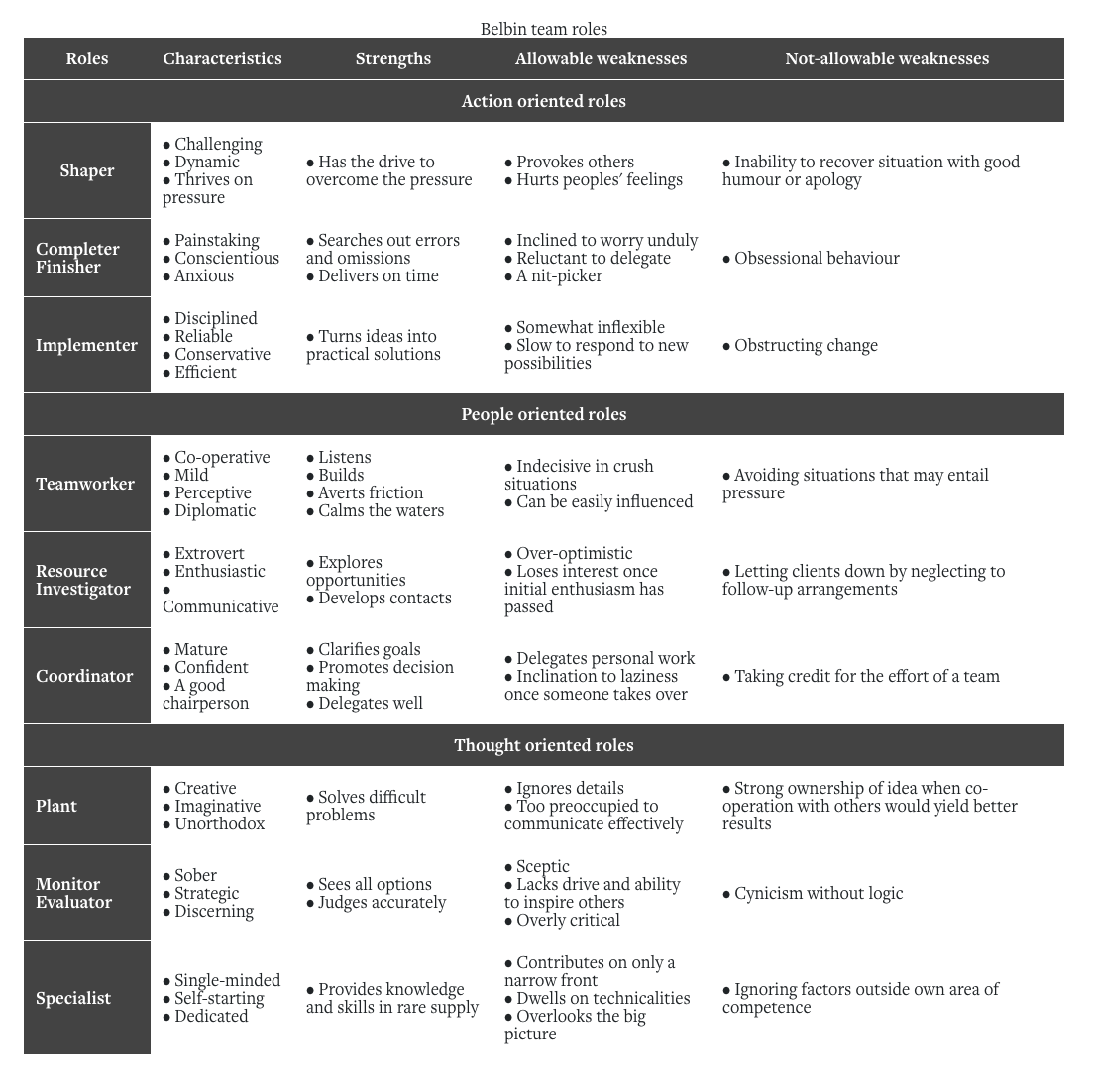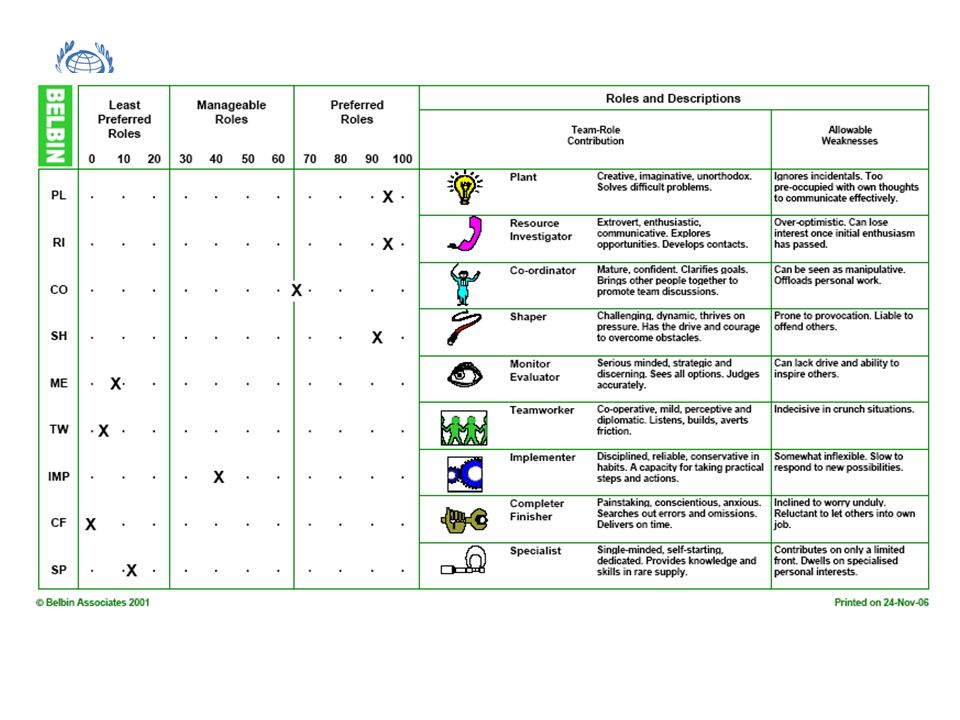Belbin Team Roles Questionnaire Topics: Belbin Team Inventory, Anxiety, B&H Photo Video Pages: 3 (1422 words) Published: June 6, 2015. Team role questionnaire ‘An individual is not perfect but a team can be’. Tend to be the most supportive member of the team and keep morale high. A Often come up with the creative ideas. Can be inflexible to new ideas too quickly at times if don’t seem very practical. The Nine Belbin Team Roles A team is not a bunch of people with job titles, but a congregation of individuals, each of whom has a role which is understood by other members. Research showed that the most successful teams were made up of a diverse mix of behaviours.
What is a Team Role?
The term 'Team Role' refers to one of nine clusters of behavioural attributes, identified by Dr Meredith Belbin's research at Henley, as being effective in order to facilitate team progress.
The research indicated that the most successful teams were made up of a diverse mix of behaviours. Each team needs access to each of the nine Belbin Team Role behaviours to become a high-performing team.
However, this doesn't mean that every team requires nine people. Most people will have two or three Belbin Team Roles that they are most comfortable with, and this can change over time. Each Belbin Team Role has strengths and weaknesses, and each role has equal importance.
It's not always necessary to have all Team Roles working simultaneously. It is important to look first at the team objectives, and then work out which tasks need to be undertaken. Once this has been done, discussions can take place regarding how and when each Belbin Team Role behaviour should be utilised.
Using Belbin can give individuals a greater understanding of their strengths, which leads to more effective communication in the team. Managers can put together great teams, enhance the performance of existing ones, and ensure that everyone feels that they are making a difference in the workplace.
What are the nine Belbin Team Roles?

The nine Belbin Team Roles are: Resource Investigator, Teamworker and Co-ordinator (the Social roles); Plant, Monitor Evaluator and Specialist (the Thinking roles), and Shaper, Implementer and Completer Finisher (the Action or Task roles).
For more information on each of the roles, please see the descriptions below.
The only sanctioned way of finding out your Belbin® Team Role strengths and weaknesses is by completing the official Belbin® Self-Perception Inventory online, and receiving a Belbin® Individual Report.
Over 3 million Belbin® Reports have been generated worldwide for individuals, managers, teams and organisations. Contact us to start your Belbin® journey.
Belbin’s Team Roles. The need for team oriented approach has developed in the recent few decades due to the fact that well organized teams are usually very high performers. Johnson et al (2008) state that for the team to be successful it can not consist of all leaders or all analytical people, but there should be harmony and right mix in order to have a successful team in place that can carry out and perform all sorts of tasks.
Bloise (2007) also supports this statement and mentions that it is the job and responsibility of the senior management in the organization to ensure that they select and recruit right candidates with right levels of competencies and skills in order to fill the gap to make successful team.
The idea of bringing together candidates with different backgrounds and core competencies in order to make a successful team was initially proposed by Meredith Belbin who stated that successful teams are consisted of a mix of individuals each of whom can perform a different role in the team (Hall, 2007). The Belbin’s team role also indicates that a right balance within the team where each individual will contribute their share with their specific role is very crucial.
The Belbin’s Team Roles consist of nine types of roles that exist within a successful team. Even though all nine types of individuals are different from each in terms of contribution they make towards the objectives of the task, the team is expected to be high-performing. Here are the following types of team roles according to Belbin’s team roles:
The co-ordinator is a person who is considered to be a chairperson in the team who has special leadership skills. Hall et al (2007) state that co-ordinator in the Belbon’s team roles is a person-oriented leader who is trusting, accepting, dominant and committed to team goals and objectives. They further state that coordinator is a person who is positive thinker and approves of goal attainment and tolerant enough always to listen to others and strong enough to reject advices when necessary. However, co-ordinator is not someone who stands out in the team and usually do not have sharp intellect as other team players.
The Shaper is a task-oriented individual who achieves objectives with vigor and who is driven by energy and the need to achieve, therefore achieving the task successfully is the main goal for the Shaper. Carnworth (2005) also states that Shaper is committed to achieving ends and will shape others into achieving the aims of the team. Therefore, it is a common practice for the shaper to disagree, challenge and argue with other team palers when carrying out the task of the team. However, more than one Shaper usually leads to a conflict in the team. Therefore, it is usually suggested that the teams should not have more than one Shaper.


Monitor Evaluators stand out in the team due to their critical thinking and analytical approach to the task. Therefore, they are fair and logical observers of what is going on in the team. Hall et al (2007) state that Monitor Evaluators usually sell all their available options with the greatest clarity and impartiality due to their special skills such as detaching themselves from bias. Due to their critical approach to all tasks in the team, they do not usually motivate other team players as they may damp enthusiasm for anything without logical grounds. Therefore, it is the job of the coordinator to ensure that these type of team players are kept to their special skills only before they discourage others for fresh ideas and enthusiasm.
Plants are creative team players, therefore they usually introduce fresh and mew ideas to the whole team. Johnson et al (2008) also state that if the team needs innovative solution, Plant would be the best solution for this issue as they are very good at brainstorming and coming up with innovative ideas. Therefore, Plants usually require free-thinking environment as they need freedom and motivation for giving fresh ideas to the team. However, multiple numbers of plants usually leads to a conflict due to vast number of ideas which may seem to be without solid grounds.

Belbin Team Roles Questionnaire Template
Resource investigators are also valuable members of any team in terms of developing new contacts and exploring new opportunities. Resource investigators mainly achieve positive results due to their increased level of enthusiasm and their communicability. However, Brooks (2009) mentions the main weaknesses of resource investigators as being over-optimistic, therefore they claims and suggestions require further analysis.
Implementers are the most down-to-earth members of the team. They differ with their efficiency and the high level of self-discipline. However, at the same time they may not take advantage of new possibilities due to their occasional inflexibility. Nevertheless this weakness is compensated with the ability of implementers to devise realistic and practical strategy, therefore implementers are also considered to be valuable members of the team.
In occasions where the team project is approaching its final stages and last minute adjustments and corrections need to be implemented completer finishers tend to be very efficient with their attention to detail and high standard. But in some other circumstances completer finishers are not very efficient with their reluctance to delegate, and tendency to worry excessively.

Team workers are the most flexible and arguably the most valuable members of the team. They usually accept responsibilities assigned to them without or with minimum objections, and can go to extra length for the sake of achievement of aims and objectives of the team. However, some team workers lack leadership skills and also may appear indecisive in critical circumstances.
Most of the teams cannot function efficiently without specialists, who apply their knowledge and experience to achieve higher results in their subject. Though, the main weakness associated with specialists as mentioned by Landale (1999) is their tendency to focus on technical aspects rather than concentrating on creating value for the team.
Belbin Team Roles Questionnaire Form
- Bloisi, W, 2007, “Human Resource Managements”, McGraw-Hill, UK
- Brooks, I, 2009, Organisational Behaviour: Individuals, Groups and Organisation, Blackwell Publishing
- Carnwoth, A, 2005, “How to form a Resourcing strategy”, People Management, UK
- Fisher, H Hunter T.A, 1998, “The structure of Belbin’s team roles”, Mcgraw-Hill, UK
- Hall,D. R. Jones, C. Raffo, I. Chambers and D Gray (2007), “Business Studies”, Pearson Education, Third edition, UK
- Landale, A, 1999, Gower Handbook of Training and Development, Gower Publishing Ltd.
- Johnson. G, Scholes. K and Whittington. R, 2006, “Exploring corporate strategy”, Prentice hall, UK, Seventh Edition